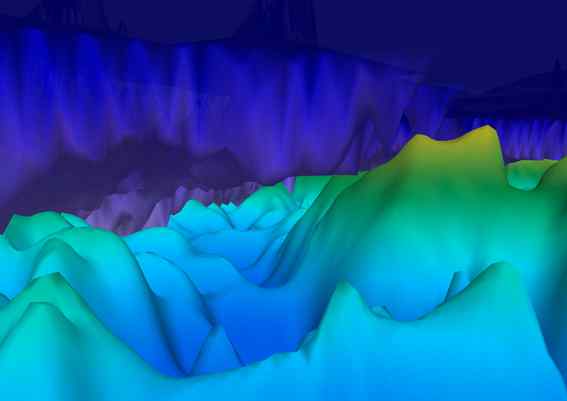Images of climate innovation
Mapping Antarctic cavities
Channels and ridges beneath ice shelves affect warm ocean water flow to the glacier front, changing how the wider glacier responds to climate change. Mapping bathymetry beneath ice shelves is challenging; this image of the sub-ice shelf is made by using measurements of variations in the Earth's gravity to feel the shape of the hidden cavity. This data comes from a project surveying Thwaites Glacier, the most significant current Antarctic contributor to global sea-level rise.

This aero geophysical survey by the British Antarctic Survey was part of the International Thwaites Glacier Collaboration. Airborne radar, which accurately measures ice thickness onshore cannot see through the water, causing mapping beneath ice shelves to be challenging. The ice shelf itself limits direct observations to risky and time-consuming missions by robotic vehicles, and surface measurements are slow, and in some cases not possible.
To solve this we used measurements of the variation in the earth's gravity to predict how deep the sub-ice shelf cavity is. This technique relies on the fact that dense rocky ridges have a positive gravity signal, while deep channels show the reverse. Retreating and thinning of the Antarctic Ice Sheet is contributing to rising global sea levels. Satellite observations show that today the largest and most significant contributor is Thwaites Glacier in West Antarctica. Many models indicate that this region is in danger of catastrophic collapse, and some suggest that the unstoppable retreat of the glacier has begun.
Thwaites glacier is vulnerable to change because its margin lies below sea level, allowing easy access for warm ocean water to melt the ice front from underneath. In addition, the increasing depth of the bedrock inland beneath the glacier sets up a feedback loop: once the retreat has started it may not stop. Accurate predictions of future change require detailed observations of the ice sheet, ocean, and land beneath.
The International Thwaites Glacier Collaboration is a major multi-disciplinary scientific effort to collect, interpret and utilise new data to make urgently needed accurate predictions of future change. The project helps decision-makers understand the likely risks of sea-level rise and allows for proportionate and timely adaptation.
Entrant: Tom Jordan , British Antarctic Survey (BAS), (Geology and Geophysics Team)
Copyright: Tom Jordan